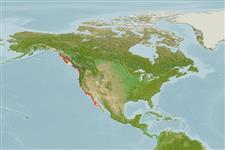Environment: milieu / climate zone / depth range / distribution range
Ecologia
marino benthopelagico; distribuzione batimetrica 0 - 30 m (Ref. 6885). Temperate; 59°N - 14°N, 136°W - 93°W
Eastern Pacific: Sitka, Alaska to Punta Banda, northern Baja California, Mexico.
Size / Peso / Age
Maturity: Lm ? range ? - ? cm
Max length : 18.0 cm TL maschio/sesso non determinato; (Ref. 2850); Età massima riportata: 9 anni (Ref. 56049)
Spine dorsali (totale): 24 - 27; Raggi dorsali molli (totale): 9-10; Spine anali 1; Raggi anali molli: 9. Spinous dorsal represented by a series of small spines, free from membrane; soft dorsal fin triangular and placed well back on body; caudal fin small and finely forked; anal fin spine small and broad, the fin mirroring the soft dorsal fin; pectorals truncate (Ref. 6885). Pale mottled brown, varying from olive green to yellow brown dorsally; creamy white ventrally; a bright silvery patch between operculum and pectorals extending to throat and bounded above by a dark band that extends forward through eye to snout; breeding males with bright red snout and phosphorescent snout (Ref. 6885).
Found in kelp beds, eelgrass, rocky areas, and over sand bottoms (Ref. 2850). Usually near the surface in schools, sometimes in dense schools well offshore (Ref. 2850). Feeds on small crustaceans and fish larvae (Ref. 6885). Minimum depth reported taken from Ref. 57178.
Nest is built, usually in kelp. Males are territorial (Ref. 6885) and guard the nest.
Eschmeyer, W.N., E.S. Herald and H. Hammann, 1983. A field guide to Pacific coast fishes of North America. Boston (MA, USA): Houghton Mifflin Company. xii+336 p. (Ref. 2850)
IUCN Red List Status (Ref. 130435)
Threat to humans
Harmless
Human uses
Acquario: Acquari pubblici
Informazioni ulteriori
BibliografiaAcquacolturaProfilo di acquacolturaVarietàGeneticaElectrophoresesEreditarietàMalattieElaborazioneNutrientsMass conversion
CollaboratoriImmaginiStamps, Coins Misc.SuoniCiguateraVelocitàModalità di nuotoArea branchialeOtolithsCervelliVista
Strumenti
Special reports
Download XML
Fonti Internet
Estimates based on models
Preferred temperature (Ref.
123201): 8.9 - 17.3, mean 10.4 °C (based on 184 cells).
Phylogenetic diversity index (Ref.
82804): PD
50 = 1.5000 [Uniqueness, from 0.5 = low to 2.0 = high].
Bayesian length-weight: a=0.00263 (0.00103 - 0.00672), b=3.14 (2.92 - 3.36), in cm total length, based on LWR estimates for this (Sub)family-body shape (Ref.
93245).
Trophic level (Ref.
69278): 3.4 ±0.42 se; based on food items.
Generation time: 2.1 ( na - na) years. Estimated as median ln(3)/K based on 1
growth studies.
Resilienza (Ref.
120179): Medio, tempo minimo di raddoppiamento della popolazione 1.4 - 4.4 anni (tm=1; tmax=9; Fec=1,200; K=0.5).
Fishing Vulnerability (Ref.
59153): Low vulnerability (25 of 100).
Nutrients (Ref.
124155): Calcium = 59.4 [36.7, 125.3] mg/100g; Iron = 0.409 [0.237, 0.732] mg/100g; Protein = 16.6 [15.4, 17.8] %; Omega3 = 0.449 [0.219, 0.928] g/100g; Selenium = 10.7 [4.5, 23.6] μg/100g; VitaminA = 46.3 [11.9, 175.5] μg/100g; Zinc = 0.781 [0.547, 1.090] mg/100g (wet weight);
